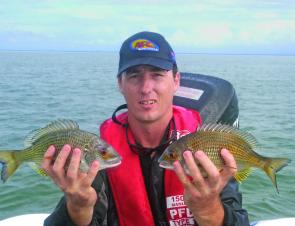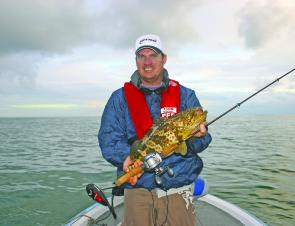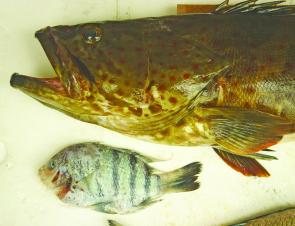All that rain we have received over the last few months is finally starting to show some great fishing results around the Northern Bay.
Estuarine species are about in healthy numbers and are hungry. The baitfish that were flushed out last month are now moving back into the rivers and holding shelter in heavy structured areas. Good schools of bream are gathering around bridge pylons and rocky outcrops upstream from the mouths of the Pine and Brisbane Rivers and are worth targeting during the last of the run-out tide.
Unlike winter, bream need a lighter approach during summer as they are a little less competitive and shy from taking big bulky weighted presentations. Downsizing to ultra light fluorocarbon line and small baits or plastics will get them in the mood.
New blade baits, like the TT’s Switchblade 1 1/2” 1/8oz in black and gold, has been dynamite for getting sensitive bream to bite. This lure is useful for targeting bream holding in the deeper water that normally would not be targeted. Once you have located fish, be sure when you get a strike not to spook the rest of the school by striking hard on the rod. Sharp or chemically sharpened hooks will allow the fish to hook itself on most occasions. Often catching one fish will excite the rest of the school and catching three or four from the same area is possible.
Flathead also inhabit the same areas of the river systems and letting your offering reach the bottom can result in good numbers. Targeting shallow flats at the bend in the river have produced some nice flathead, especially if it has some rocky patches. Using hardbodied lures, like Jackall Chubbies and Ecogear SX40, is working well with plenty of short pauses and small rips. Soft plastics are also worth using on the mudflats, but can often get smashed to pieces by the plagues of small blowies.
Some great surface bites have been happening around the bay islands last month and big tailor have been the main attraction. Working shallow reef flats adjacent to deep drop-offs on low tide and the first half of the run-in with surface baits, small poppers and wake baits will get the adrenaline flowing through your veins.
Watching fish slice bow waves in less than 1ft of water as they chase down your lure is something to behold and stays in the back of your mind forever. The surface explosions are reminiscent of bigger GT’s of the north. Although there a few rat choppers amongst them, most tailor are around the 2kg+ mark.
Small surface walk-the-dog type hardbody lures, like Lucky Craft’s Sammie, can produce fish from water barely deep enough to work. Good bream, flathead, whiting and trevally have also been responding well to these surface baits and are keeping fishing interesting. It is great to watch the different attacks these species display. Bream pop at the surface and make several attacks before swallowing the lure. Whiting attack from underneath and can bounce the lure clear from the water and tailor rip and slash at the walk bait that they make a hell of a racket. It is important to continue walking the lure across the surface regardless of the commotion happening around it or a missed fish could shy away and spook.
The Pearl Channel has been a little hit-and-miss with the bigger tides of late. Plenty of fish are holding around the coffee rocks but it is just too much hard work trying to get a bait or plastic down to them. Waiting for the current to slowly ease near the tide turn has produced a few nice cod, parrot and sweetlips on the rubble ground surrounding the reef systems. Bigger jig heads and braided lines will assist to fish the area longer and jerk baits are good producers.
Finding deep schools of bait along the many sandbar drop-offs make it worth jigging a few metal slices and plastics. Big tailor are showing up in good numbers in the Northern Bay for the first time in several years.
During the end of January, the EPA held a ‘Public Consultation’ meeting on the re-zoning of Moreton Bay. Unfortunately, I could not attend the Redcliffe meeting but instead attended the meeting held at Sandgate the following night. This so-called ‘Public Consultation’ meeting was, in my view, a complete waste of fisher’s, politician’s and the EPA’s time.
The format in which the meeting was held saw several EPA representatives walking around talking to small groups of people, instead of holding an open floor for real issues to be raised and brought to the forefront as a united voice. The so-called ‘Public Consultation’ was nothing more than the EPA’s way of telling the public that there is no other option but what has been outlined in the draft.
Two of the most important details did come to light at the meeting; the proposal to build an artificial reef; and the Green-Zone issue.
The purpose of the proposed government built artificial reef was to lessen the impact on the public and its recreational use of the bay. This seems a costly exercise to give anglers a resource that they already possess thanks to nature. Surely introducing a new artificial reef system would have a far greater impact on the natural state of the bay.
If the government need to honour their political promises to the green sector in order to maintain their current employment status then let them build the ‘high impact’ artificial reef and declare it a Green Zone!
The second important detail discussed was the issue of the Green-Zone that has been put out in the Paddock. This area has apparently been chosen for its bio-diversity to help overcome pollution levels through the bay.
In essence, this is a great idea but it comes at a cost to the community. Instead of the government attacking the real issues of siltation and phosphate rich run-off from local farming and industry entering our water ways, the community have to lose an area that has been used for recreation purposes for decades.
More and more the Brisbane River is losing vital wetlands and mangroves but somehow industry seems more important to the government than the people. Money talks.
Other areas that are having a blind-eye turned is the siltation caused from land reclamation at the Brisbane port and airport, as well as the toxic bilge discharge from every international super tanker that enters the Brisbane River – and the list goes on!
In summary, it’s seems so much easier (and cheaper) to take from the community a part of their recreational (and professional) activities rather than draft a plan to tackle commercial impact on Moreton Bay. As far as I can see the re-zoning is a done deal and the community will ultimately lose out.
Reads: 1147
Jason with his fist’s full of healthy bream from the flats.

Nice cod are biting when the tide slows at the Pearl Channel.

The small sergeant major was expelled from the cod soon after capture. Big cod means big bait.




